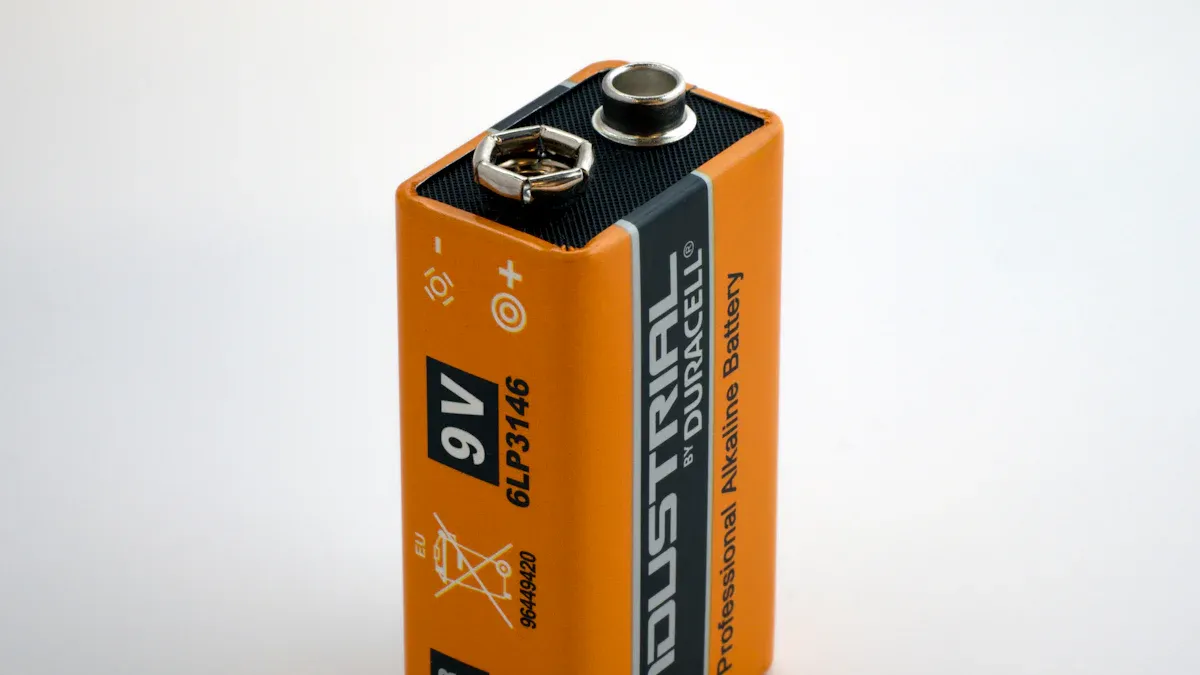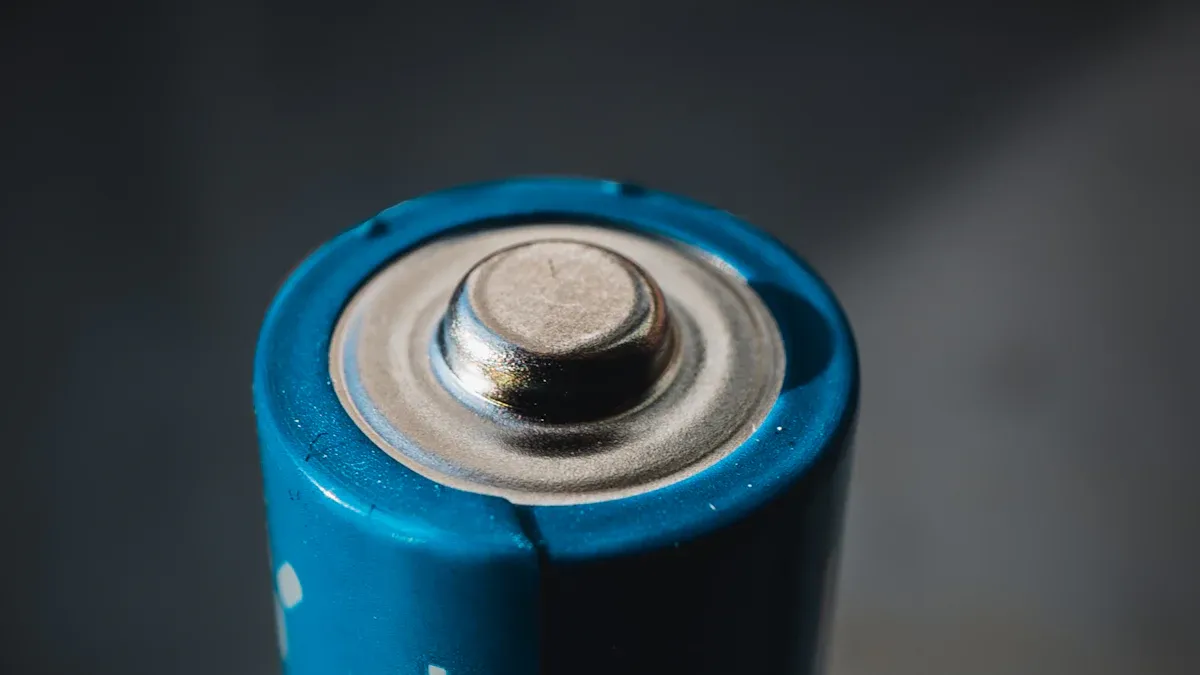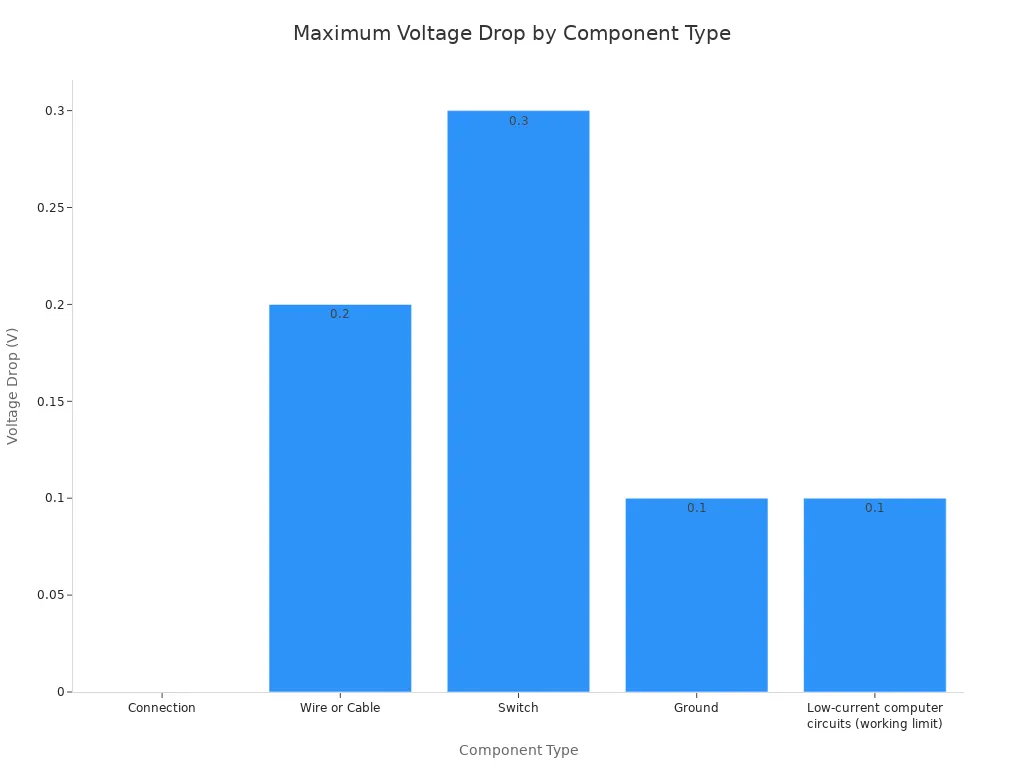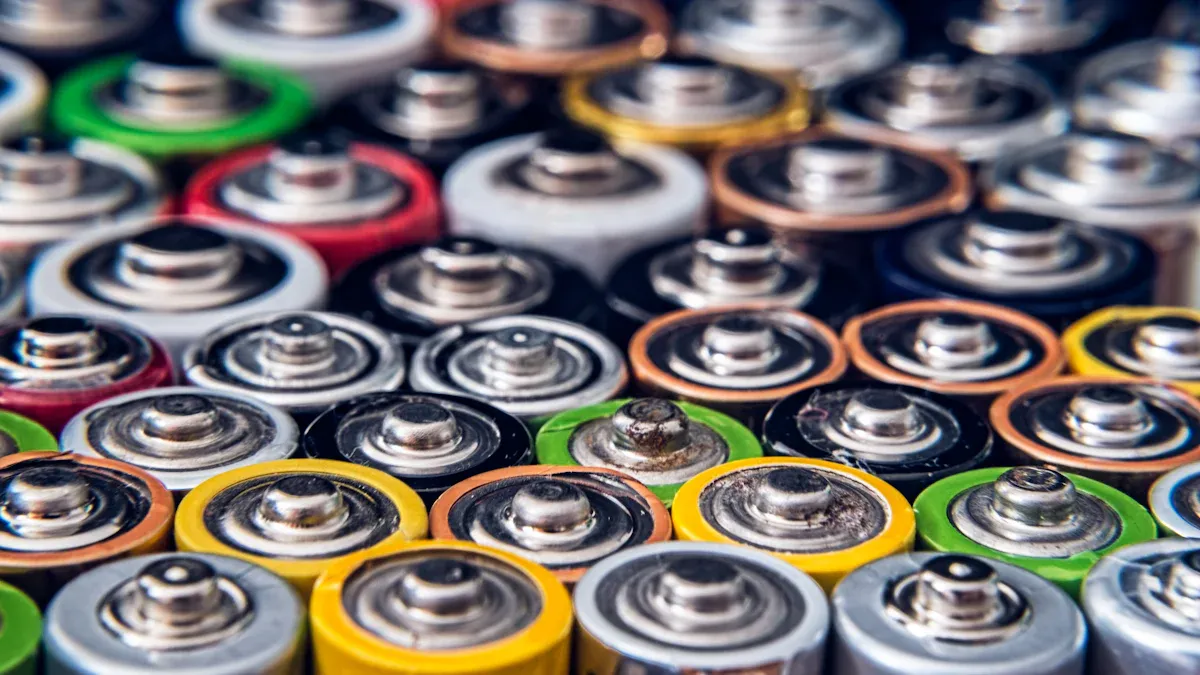
I’ve noticed that your device’s discharge rate significantly impacts the performance of alkaline batteries, reducing their effective capacity and lifespan. High discharge rates mean your alkaline batteries won’t last as long as expected, leading to frequent replacements and frustration.
Key Takeaways
- High discharge rates make alkaline batteries lose power faster. This means they do not last as long in devices that need a lot of power.
- Some devices use a lot of power. These include gaming controllers, digital cameras, and motorized toys. Alkaline batteries are not the best choice for these items.
- Choose the right battery for your device. Use alkaline batteries for low-power items. Use lithium or rechargeable NiMH batteries for high-power items.
Understanding Discharge Rate and Its Impact on Alkaline Battery Capacity

What is Battery Discharge Rate?
I often explain battery discharge rate as the speed at which a battery releases its stored energy. It represents the amount of current a battery can deliver at a given time. We typically express this as a fraction or percentage of its total capacity. For instance, if a battery has a capacity of 1000 mAh, a 1C discharge rate means it can deliver 1000 mA for one hour. This rate is measured in units like amps or milliamps per hour (Ah or mAh), indicating the current drawn from the battery over a specific duration. Understanding this concept is crucial because it directly influences how long your batteries will power your devices.
The Peukert Effect: Why Alkaline Batteries Suffer
When I analyze battery performance, I always consider the Peukert Effect. This phenomenon describes how a battery’s usable capacity decreases as the discharge rate increases. For alkaline batteries, this effect is particularly pronounced. The general formula for Peukert’s Law is given as: It = C * (H / I)^k. Here, H is the rated discharge time in hours, C is the rated capacity at that discharge rate in Ampere-hours, I is the actual discharge current in Amps, and k is the Peukert constant. The ‘k’ value, which is typically greater than 1 for most batteries, indicates how much the capacity is reduced at higher currents. For alkaline batteries, I have seen studies confirming the applicability of Peukert’s Law, often with a Peukert constant around 1.06. This means that if you draw current faster, you get less total energy out of the battery than its nominal rating suggests. It is a fundamental limitation I always account for when recommending battery solutions.
How High Discharge Rates Reduce Effective Capacity
High discharge rates significantly reduce the effective capacity of an alkaline battery. When a device demands a lot of current quickly, the internal chemical reactions within the battery struggle to keep up. This leads to a phenomenon where the battery’s voltage drops more rapidly than it would under a lower, steady load. I observe that this voltage drop can cause devices to stop functioning, even though there is still some energy left in the battery. The internal resistance of the battery also plays a larger role at higher discharge rates, converting more of the stored energy into heat rather than usable power. Consequently, the total amount of energy you can extract from the battery before it becomes unusable for your device is much lower than its advertised capacity. This is why a battery rated for 2000 mAh might only deliver 1000 mAh in a high-drain application.
Real-World Consequences for Your Devices and Alkaline Batteries
When I consider how devices use power, I see direct impacts on battery performance. High discharge rates do not just affect theoretical capacity; they create tangible problems for your electronics and the batteries powering them.
Shorter Battery Life in High-Drain Devices
I often observe that devices demanding high power drain batteries much faster than expected. For example, a toy car with a powerful motor or a digital camera taking many flash photos will deplete its batteries quickly. This happens because the battery struggles to deliver a large amount of current efficiently. The internal chemical reactions cannot keep pace with the demand. As a result, you find yourself replacing batteries more frequently. This leads to increased costs and inconvenience. I always advise users to consider this when choosing batteries for power-hungry gadgets.
Voltage Drop and Device Malfunctions
I have seen many devices malfunction or shut down prematurely due to voltage drop. When a battery discharges at a high rate, its voltage can drop significantly. Electronic devices have specific voltage requirements to operate correctly. Many devices include an undervoltage-lockout (UVLO) circuit. This circuit turns off the device’s power if the voltage falls below a safe operational value. This prevents unpredictable system behavior. For instance, battery-powered embedded devices use UVLOs to monitor battery voltage. They shut down the device if the voltage drops too low. This protects the equipment from deep discharge.
Excessive voltage drop can cause electrical components to underperform or fail. Technicians measure and diagnose voltage drop to maintain system efficiency. I find this table helpful for understanding common voltage drop limits:
| Component Type | Maximum Voltage Drop (V) |
|---|---|
| Connection | 0.00 |
| Wire or Cable | 0.20 |
| Switch | 0.30 |
| Ground | 0.10 |
| Low-current computer circuits (working limit) | 0.10 |
This chart further illustrates how different components tolerate voltage drops:

Even a small voltage drop can prevent a device from working. Your device might indicate “low battery” and shut off, even if some energy remains.
Increased Heat Generation and Battery Degradation
High discharge rates also generate more heat within the battery. I know that batteries have internal resistance. When current flows through this resistance, it creates heat. The faster the current flows, the more heat the battery produces. This increased temperature is detrimental to battery health. The maximum safe operating temperature for an alkaline battery before significant degradation occurs is generally 50°C (122°F). While they can operate slightly higher, up to about 54°C (130°F), I do not recommend this. Higher temperatures increase the risks of leakage and reduce overall performance. This heat accelerates the chemical reactions inside the battery. It can permanently reduce the battery’s capacity and shorten its overall lifespan.
Identifying High-Drain Devices That Hurt Alkaline Batteries
I often find that certain devices consistently drain alkaline battery power much faster than others. These “high-drain” devices demand significant current, which quickly diminishes the battery’s effective capacity.
Common Culprits: Gaming Controllers and Digital Cameras
I frequently observe gaming controllers and digital cameras as primary culprits. A wireless gaming controller, for instance, constantly communicates with the console and powers vibration motors, demanding bursts of high current. Similarly, digital cameras, especially when using the flash or continuous shooting modes, draw substantial power. These devices quickly exhaust alkaline batteries, leading to frequent replacements.
Power-Hungry Toys and Portable Audio Players
I also identify power-hungry toys and portable audio players as significant drains. Motorized toys, like remote-control cars or electric skateboards, require considerable power for their motors. I know that the power output of motors in electric skateboards, a type of motorized toy, typically ranges from 100 to 2000 watts. This high wattage translates to rapid battery depletion. Portable audio players, particularly older models or those with powerful amplifiers, also consume a lot of energy, especially at higher volumes.
Flashlights and Other High-Intensity Electronics
I consider flashlights, especially high-intensity LED models, and other high-power electronics to be major battery consumers. A flashlight utilizing an XRE R2 LED powered by a single 18650 battery can draw approximately 1 amp on its high setting. More generally, high-intensity LED flashlights typically draw around 3 amps. Drawing significantly more than 3 amps is considered a high current draw for most LED flashlights, particularly stock models. These devices demand a steady, high current, which quickly reduces the lifespan of an alkaline battery.
The Impact of Discharge Time on Alkaline Battery Capacity: Case Studies
I often find that real-world device usage clearly illustrates how discharge time affects alkaline battery capacity. Different devices draw power at varying rates, leading to vastly different battery lifespans.
Digital Camera vs. Remote Control: A Capacity Comparison
I frequently observe a stark contrast when comparing an alkaline battery‘s life in a digital camera versus a TV remote. A remote control draws minimal current, allowing the battery to deliver close to its rated capacity over a long period. However, a digital camera, with its flash, zoom motor, and LCD screen, demands high current bursts. This significantly reduces the effective capacity of the alkaline battery, making it seem like it dies much faster. I see the camera quickly depleting batteries, while the remote control seems to last forever.
The Rapid Drain of a Motorized Toy
Motorized toys are another example where I observe rapid battery depletion. Their electric motors require a constant, high current to operate. This sustained high discharge rate quickly exhausts the alkaline battery. I notice this leads to short playtimes and frequent battery changes. The toy might run for only a fraction of the time compared to a low-drain device, even with the same battery type.
How a High-Powered LED Flashlight Drains Alkaline Batteries Fast
When I look at high-powered LED flashlights, I see a classic case of rapid alkaline battery drain. The initial current draw can be very high, especially with new alkaline cells. I know that determining a general discharge curve for an alkaline battery powering such a flashlight is complex due to many variables. The initial current draw can be very high, potentially leading to overheating within seconds if there is no current limiting. The current significantly drops over time. Factors like the battery’s internal resistance and the LED’s forward voltage (Vf) heavily influence this. This high initial demand and subsequent drop mean the alkaline battery delivers less usable energy, quickly dimming the light.
Choosing the Right Battery for the Job: Beyond Alkaline Batteries
I understand that selecting the correct battery type is crucial for device performance and battery longevity. Sometimes, alkaline batteries are not the best choice.
When to Stick with Alkaline Batteries
I find that alkaline batteries remain a reliable and cost-effective option for many household devices. They offer superior energy density and shelf life compared to some other battery types. I often recommend them for low to moderate-drain devices. These include remote controls, clocks, and many toys. They also work well in portable electronics that do not demand high power. Alkaline batteries provide a practical solution for everyday needs without a high price tag. This makes them a budget-friendly choice for routine gadgets. They ensure smooth functionality without unnecessary expense.
The Benefits of Lithium and NiMH Rechargeable Batteries
When devices demand more power or frequent use, I look beyond alkaline batteries. Lithium batteries offer significant advantages. They boast a higher nominal voltage, typically 3.2–3.7 volts per cell, compared to alkaline’s 1.5 volts. Lithium batteries also have a much higher energy density, often over 200 Wh/kg, while alkaline batteries are around 80-120 Wh/kg. This means lithium batteries pack more power into a lighter package. For rechargeable options, I often suggest NiMH batteries. Unlike single-use alkaline batteries, NiMH batteries are easily rechargeable. They offer a cycle life of 500–1000 recharges. This makes them a more environmentally friendly choice, especially for frequently used devices.
| Battery Type | Nominal Voltage | Energy Density (Wh/kg) | Lifespan/Cycle Life |
|---|---|---|---|
| Alkaline | 1.5V | 80–120 | Single-use |
| Lithium | 3.2–3.7V | 150–250+ | Single-use |
| NiMH | 1.2V | 60–120 | 500–1000 cycles |
Matching Battery Type to Device Power Needs
I always emphasize matching the battery type to the device’s specific power needs. For low-drain devices, alkaline batteries are often sufficient and economical. However, for high-drain devices like digital cameras or gaming controllers, lithium batteries provide the necessary power and longer runtimes. For frequently used items, NiMH rechargeable batteries offer a cost-effective and sustainable solution over time. Understanding these differences helps you make smarter battery choices.
Maximizing Your Alkaline Battery Life

I always look for ways to extend the life of alkaline batteries. Proper care and understanding their limitations can make a big difference.
Best Practices for Storage and Usage
I find that correct storage is key to preserving battery life. To maximize their shelf life, I recommend storing alkaline batteries in a cool, dry place. It is crucial to avoid extreme temperatures and humidity, as these conditions can degrade battery components and significantly reduce their lifespan. I aim for cool room temperature, ideally around 20–25°C, with approximately 50 percent relative humidity. I never freeze batteries, as freezing can alter their molecular structure. High heat also accelerates self-discharge and causes unnecessary stress on the battery.
Avoiding Extreme Temperatures
I know that temperature plays a critical role in battery performance. Alkaline batteries perform optimally at room temperature (20–25°C). While high temperatures can lead to faster discharge, they can also cause damage or leakage over time. Batteries inherently lose charge due to internal chemical reactions, a process known as self-discharge. Therefore, storing alkaline batteries above 25°C would likely accelerate their self-discharge rate due to increased chemical activity. I always keep my batteries away from direct sunlight or heat sources.
Understanding Your Device’s Power Requirements
I believe understanding your device’s power needs is fundamental. Most alkaline batteries, including common household sizes like AA, supply a voltage of 1.5V. They are generally better suited for low to moderate power devices. While they can deliver several amps when new, their internal resistance increases as they deplete. This can cause voltage sag under high current draw. I find this table helpful for a quick reference:
| Battery Type | Standard Voltage | Capacity range |
|---|---|---|
| Alkaline | 1.5V | 1500-3000mAh |
I always check my device’s manual to ensure I am using the most appropriate battery type.
Johnson New Eletek: Your Partner for Quality Batteries
Our Commitment to Quality and Sustainability
I believe in responsible manufacturing. Johnson New Eletek prioritizes mutual benefit and long-term partnerships. We commit to reducing environmental impact. We also meet consumer demands for reliable energy solutions. I incorporate sustainable practices into our manufacturing and packaging. This aligns with the growing demand for eco-friendly solutions. Our focus on sustainability resonates with environmentally conscious consumers. We demonstrate a commitment to both performance and responsibility. I adhere to stringent industry standards. We earn certifications that validate our commitment to quality and safety. We prioritize environmental responsibility by implementing sustainable production practices. These certifications highlight our dedication to reducing environmental impact. We deliver high-quality products. This reinforces our compliance with international standards.
A Wide Range of Battery Solutions
I offer a comprehensive selection of battery types. We manufacture various kinds of batteries. Our products include:
- Alkaline Battery
- Lithium Ion Battery
- Button Battery (AG, CR)
- Carbon Zinc Battery
- Ni-CD Battery
- Ni-MH Battery
I ensure we have a solution for almost any device.
Expert Consultation and Competitive Solutions
I provide excellent customer support. Our professional sales team serves clients worldwide. We respect our customers. We offer consultant service and the most competitive battery solutions. I also provide immediate and specialist after-sale service. Our consultant group supplies this support. We offer complete after-sales service, including a 2-year warranty. We also develop custom new programs according to client demand.
I conclude that high discharge rates severely impact alkaline battery capacity and lifespan. Understanding this helps me make smarter battery choices for my devices. Selecting the right battery type saves money and improves performance. I recommend partnering with Johnson New Eletek for quality, sustainable battery solutions.
FAQ
Why do my alkaline batteries die so quickly in some devices?
I find high-drain devices demand a lot of current. This demand significantly reduces the alkaline battery’s effective capacity. It makes them drain faster than expected.
What battery type should I use for high-drain devices?
I recommend lithium or NiMH rechargeable batteries for high-drain devices. They offer better performance and longer life compared to alkaline batteries in these applications.
What is the Peukert Effect?
I know the Peukert Effect describes how a battery’s usable capacity decreases. This happens when the discharge rate increases. Alkaline batteries are particularly susceptible to this effect.
Post time: Nov-05-2025




